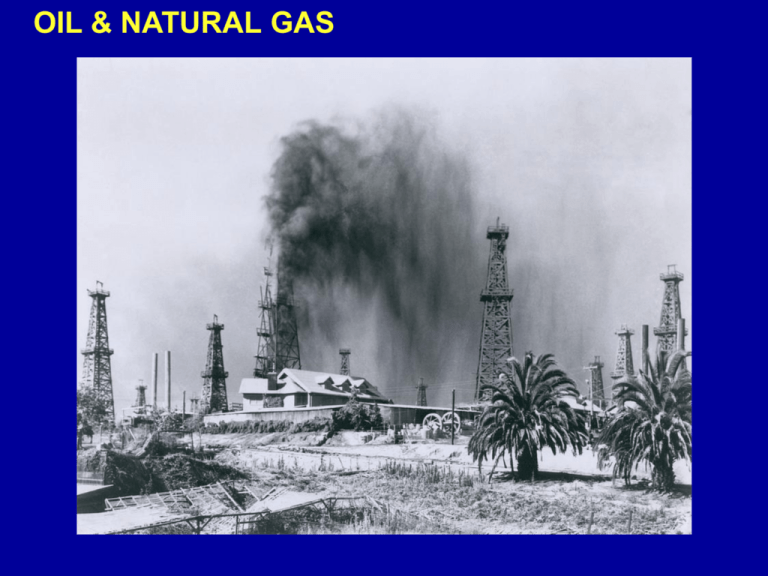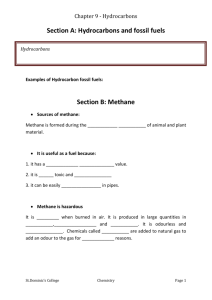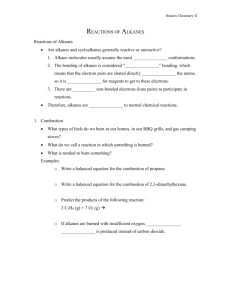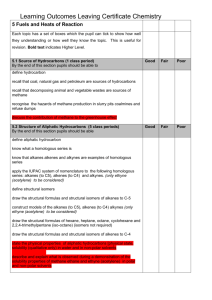Lecture5
advertisement

OIL & NATURAL GAS World Energy Consumption, by Source (2013) [EIA = Energy Information Administration] Petroleum: 1. What is it? 2. How does it form? 3. Where does it form? 4. How do we find it? 5. How do we remove it? 6. How do we process it? 7. What do we use it for? 8. How much is left? What do you want in an energy fuel source? • Easily transportable (liquid or gas) • Give off energy when participating in a chemical reaction (“exothermic” not “endothermic”) • High energy density How many different kinds of liquids exist naturally on Earth? How many different kinds of liquids exist naturally on Earth? How many different kinds of gases exist naturally on Earth? Water NEEDS energy to be broken down (endothermic reaction): Example: Electrolysis of water 2H2O + energy 2H2 + O2 Hydrogen is a good energy source: Hydrogen is a good energy source: But you can’t find it naturally on Earth Water gives off energy if it oxidizes certain materials Example: Oxidation of sodium 2Na + 2H2O 2NaOH + H2 + Energy But needs pure sodium (doesn’t exist in nature) and is quite dangerous Gasoline: Natural Gas: Natural Gas (methane): Combusts in an exothermic reaction CH4 + 2 O2 → CO2 + 2 H2O + Energy (heat, light) Natural Gas (methane): Combusts in an exothermic reaction CH4 + 2 O2 → CO2 + 2 H2O + Energy Why doesn’t it happen immediately? (i.e., why is there any natural gas in existence?) Activation Energy Can also be: Liquid Natural Gas How do you do this? Tar: Tar: Also occurs naturally Example: La Brea Pitch Lake (Trinidad) Petroleum: Petroleum or crude oil is a naturally occurring, flammable liquid consisting of a complex mixture of hydrocarbons (molecules containing carbon and hydrogen) of various molecular weights and other liquid organic compounds, that are found in geologic formations beneath the Earth's surface. What pattern do you observe? A hydrocarbon is an organic compound consisting entirely of hydrogen and carbon. Different types of hydrocarbons are 1.Alkanes 2.Cycloalkanes 3.Aromatic hydrocarbons (Arenes) 4.Alkenes 5.Alkynes Alkanes:(parafi ns, saturated hydrocarbons) Saturated in hydrogen, all C-H bonds are “single bonds” (share two electrons) What pattern do you observe about boiling and melting points? Which is most similar to water? Example of Alkanes: Octane: Pentane: Cycloalkanes: How is this different? Cycloalkane: (naphthenes) are types of alkanes which have one or more rings of carbon atoms in the chemical structure of their molecules. Ex: cyclobutane Aromatic hydrocarbons (Arenes) – Have alternating single and double bonds between carbons Ex: Benzene Alkenes – (olefin, or olefine) is an unsaturated (fewer hydrogen atoms) chemical compound containing at least one carbon-to-carbon double bond Ex: Ethylene - (C2H4) [Compare to Ethane - (C2H6)] Alkynes – (acetylenes) are hydrocarbons that have a triple bond between two carbon atoms, with the formula CnH2n-2 Ex: ethyne - C2H2 Petroleum: ..but varies! Petroleum: But I thought hydrocarbons were just carbon and hydrogen? Where did the other stuff come from? Petroleum: …but varies! Natural gas - primarily methane, with 0-20% higher hydrocarbons (primarily ethane) Gasoline (petrol) - refined alkanes from pentane (C5H12) to octane (C8H18) are refined into petrol Diesel Fuel and Kerosene (used for jet fuel) - alkanes from nonane (C9H20) to hexadecane (C16H34) Fuel oil and lubricating oil - alkanes from hexadecane upwards Paraffin wax - an alkane with approximately 25 carbon atoms Asphalt - made from alkanes with 35 carbon atoms and up Hydrocarbons may be mixed with other nonhydrocarbons, to create other end products: • Alkenes can be manufactured into plastics • Lubricants (light machine oils, motor oils, and greases) • Wax • Bulk tar • Asphalt • Paraffin wax • Aromatic petrochemicals to be used as precursors in other chemical production (such as almost all of our pharmaceuticals and fertilizers) Fig. 7-8, p. 213 Combustion: All alkanes react with oxygen in an exothermic combustion reaction, although they become increasingly difficult to ignite as the number of carbon atoms increases. The general equation for complete combustion is: CnH2n+2 + (1.5n+0.5)O2 → (n+1)H2O + nCO2 + energy (What are the end products?) Combustion: Normally, for methane: CH4 + 2O2 → CO2 + 2H2O + Energy (the end products are water and carbon dioxide) Combustion: However, without sufficient oxygen, carbon monoxide or even soot can be formed: CnH(2n+2) + nO2 → (n+1)H2O + nCO + Energy For example, for methane: 2CH4 + 3O2 → 2CO + 4H2O + Energy (note: the end products are water and carbon monoxide) Many steps are needed to go from this: to this: (Octane) Formation of Petroleum: 1.Ocean organisms (algae, zooplankton) die and sink to the ocean floor 100-500 million years ago. 2.Burial is rapid (geologically!) and anoxic. 3.Deep burial results in high temperatures that result in the “cracking” of complex organic molecules (like kerogen) into lighter hydrocarbons. 4. Most liquid and gas hydrocarbons rise up to the surface and reenter the carbon cycle. 5. If an appropriate “cap rock” exists (usually shale), then the hydrocarbons stay underground. 6. Certain geologic events (faults, folds, salt domes) can concentrate the hydrocarbons, making them economically viable to remove. Formation of Petroleum: “Cracking” is an endothermic reaction (you need to give it energy), but the Earth provides the energy over long periods of time! Ex: YOU can make natural gas from glucose in the following reaction: C6H12O6 + Energy → 3CH4 + 3CO2 (glucose) Gas/Ice Giants Cassini’s voyage to Saturn’s moon Titan. Titan: only moon with a substantial atmosphere (nitrogen) Liquid methane on a water-ice surface? Lakes (liquid methane/ethane) at Titan’s north pole (Cassini) Lakes (liquid methane/ethane) at Titan’s north pole (Cassini) New research: Titan could (theoretically) support microbial life that breathes hydrogen (missing from surface) and ingests acetylene (missing from atmosphere). Petroleum that reaches the surface is “eaten” by certain types of bacteria (La Brea tar pits) Certain types of archaea will produce methane (methanogens) Certain types of archaea will produce methane (methanogens) The energy is released by the oxidation of hydrogen: CO2 + 4H2 → CH4 + 2H2O Methanogens cause marsh gas in wetlands (two billion tonnes of methane per year) and in off-shore ocean sediments, and gas from animals (cattle, termites, etc.)







